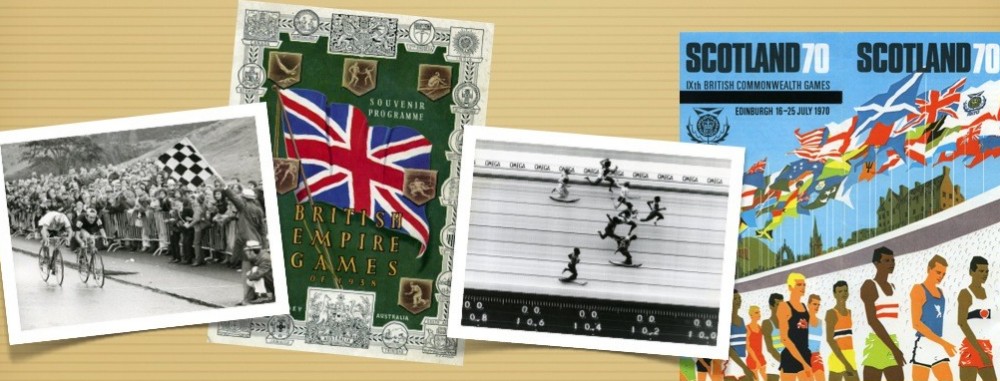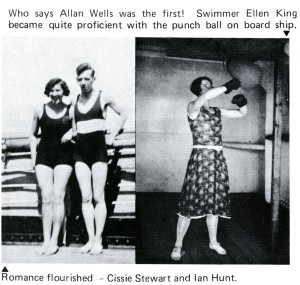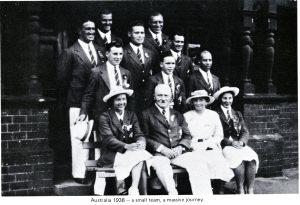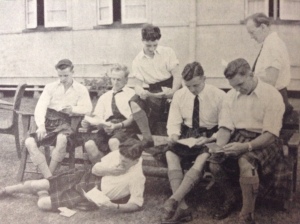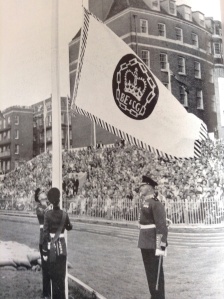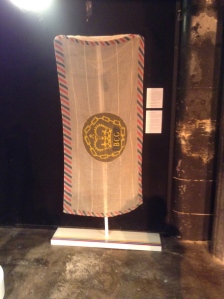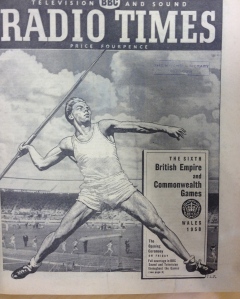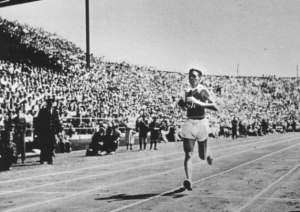As part of our exhibition Hosts and Champions: Scotland in the Commonwealth Games we discovered a number of fascinating and amazing stories about Scots in the Games which we celebrated in a list of ‘Strange Tales From the Archive’. The following provides a sample of the stories we found and images from the archive.
Hamilton 1930
Cissie Stewart:
Swimmer Cissie Stewart from Dundee won two bronze medals in Hamilton, but her life changing moment occurred immediately afterward when she eloped to Niagara Falls with The Scotsman journalist Ian Hunt. She had concealed her wedding dress in an additional suitcase and did not reveal to anyone what she was about to do.
Ellen King;
King, one of Scotland’s greatest swimmers of the period with multiple titles and records to her name, established Zenith Ladies Swimming Club in 1925 in response to the constraints of male administrators, and helps illustrate one of the ways in which women’s sporting practices were negotiated during the period. this image reveals how she maintained her strength and fitness for swimming without a swimming pool on the journey to Canada. Using a punchball showed ingenuity and recognised leading female swimmers understood the need for strength conditioning – although it would not have been known as such then.
London 1934
Scotland didn’t send a cycling team to the London Games because the governing body of the sport, the National Cyclists Union, was an English organisation with a Scottish branch. The NCU also represented professional cyclists, which was against the rules of the Empire Games movement of the time. Scottish cyclists did not enter the Games until 1950.
Sydney 1938
Ten competitors represented Scotland: eight men and two women. It took six weeks to sail to Australia on the liner ‘Ormonde’, and the team were away from Scotland for four months. The Australians gifted Scotland £600 Australian pounds (just over £400 sterling) to travel to the Games. The SNSF employed a fundraiser to raise the remaining £600 required to cover the 10 competitors to travel to the Games. The team travelled with the English and Welsh teams, and shared trainers and equipment on board.
1942
In 1938 the Lord Provost of Edinburgh pursued the idea of holding the Games in Scotland. However, Canada won the right to host the Games which were cancelled because of the Second World War.
Auckland 1950
Alan Paterson (High Jump) and Andrew Forbes (Middle-distance Runner) would be the first Scottish athletes to fly to the Games due to the constraints of their employers. Paterson, a chartered accountant, and Forbes, who worked for electronics company Philips, were funded by cinema magnate Sir Alexander King, to fly via Iceland, Gander, Hawaii and Fiji on the way to Auckland. The flight from Prestwick took one week to get to New Zealand and the pair arrived two days after the main party sailing on the cruise liner Tamaroa docked in Auckland. Both would win silver medals in their respective sports.
Female athletes on the Tamaroa had a chaperone on the sea voyage to New Zealand, Mrs W. G. Todd, who brought along balls of wool and knitting needles to keep the young women occupied and ‘out of mischief’.
Vancouver 1954
Scots marathon runner Joe McGhee won the gold after English athlete, and world record holder, Jim Peters collapsed with less than a lap to the finish line. Peters entered the stadium 20 minutes ahead of the Scot.
The Scotland Team’s return flight home was delayed for engine repairs, so during the extended wait general team manager, Willie Carmichael, took the whole team to the cinema to see Three Coins in a Fountain.
Cardiff 1958
The British Empire & Commonwealth Games Flag seen above was first used in 1958 for the Cardiff Games. In Edinburgh 1970 the flag was stolen from a flagpole by a student working for John Menzies who forty years later returned it to Commonwealth Games Scotland and was used in our exhibition.
The Games in Wales were the first to be televised live to a Scottish audience. The multisport event was so popular with viewers it inspired the BBC to introduce the programme Grandstand later that year. The first programme was presented by Peter Dimmock, but as the Head of Outside Broadcasts he was considered too busy to continue and his place was taken by David Coleman in his first major TV role.
Kingston 1966
Scottish runner Jim Alder won gold in the marathon, but not before being misdirected by an official, missing the entrance to the stadium, overtaken by Englishman Bill Adcocks, and then overtaking him on the final lap to victory.
Alder also competed in the 10,000 metres 3 days earlier. The Scots administrators had told him not to run and save himself for the marathon, but alder and his coach disagreed and he ended up with a bronze medal. Rather than being congratulated the Scots management simply told him “you better win the marathon!”
